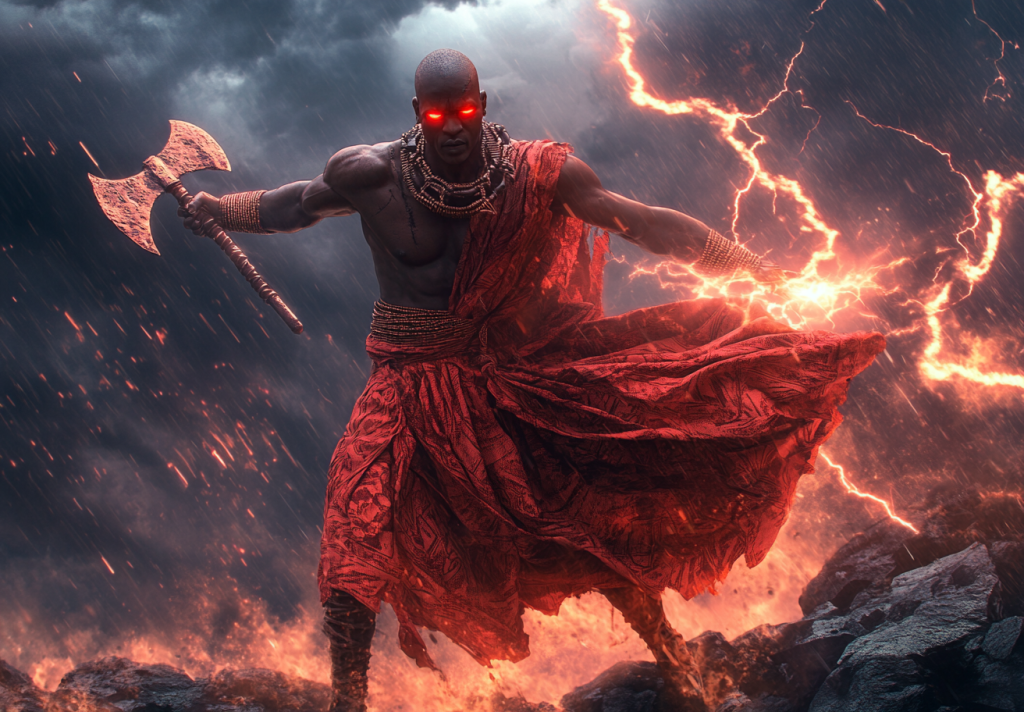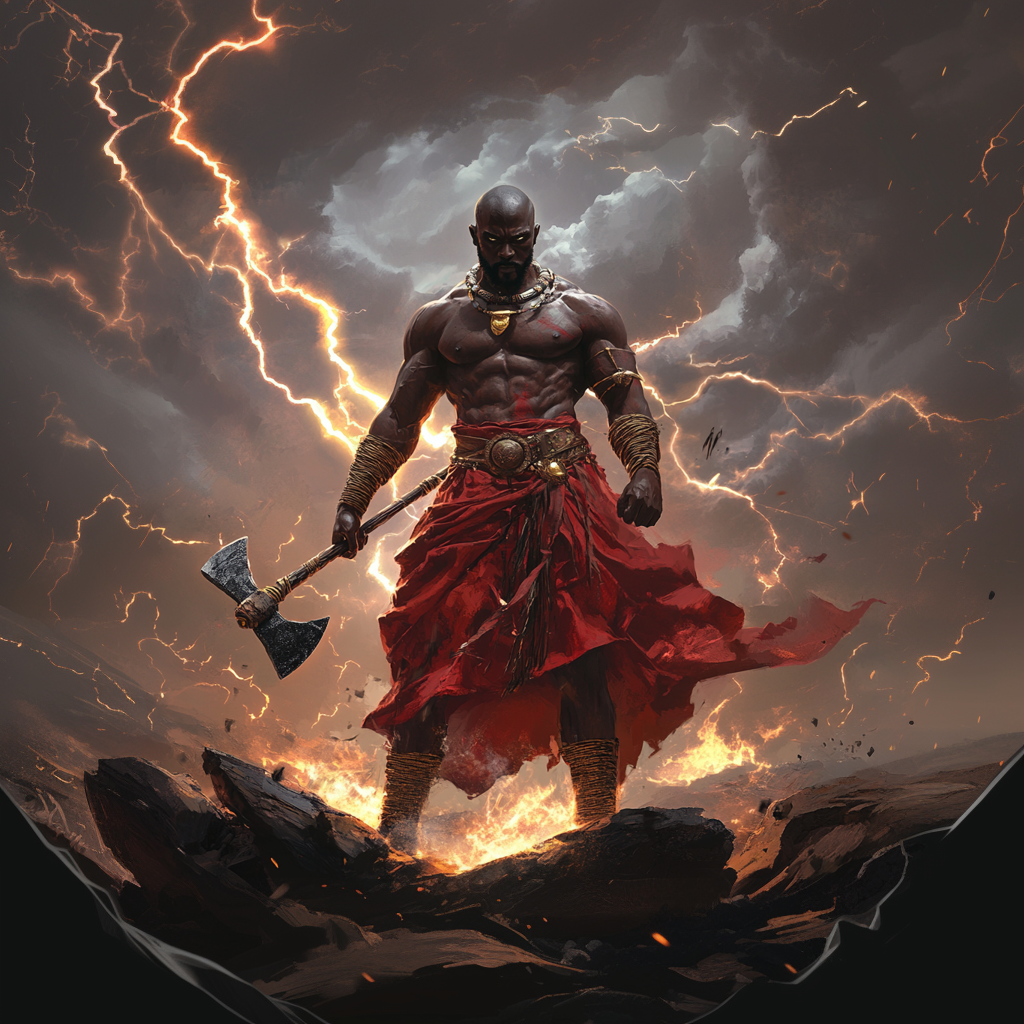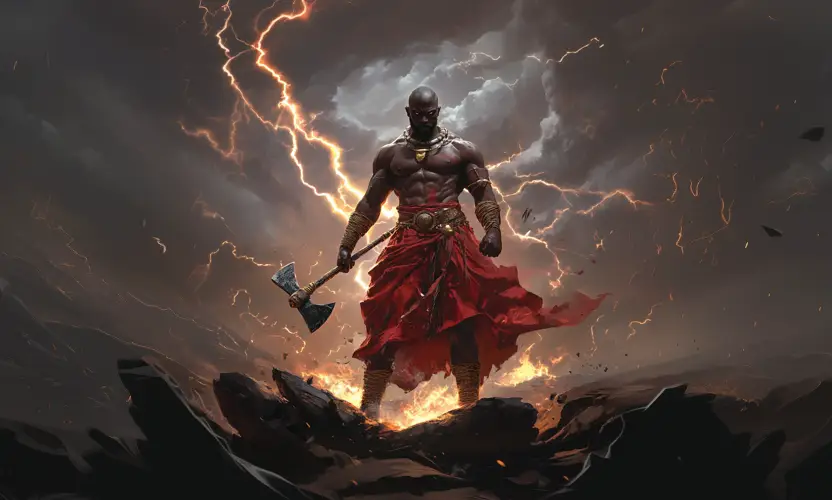When most people think of the gods of Thunder and Lightning, their minds instantly go to Thor, the fabulous hammer-wielding Norse god. However, for the Yoruba people worldwide, the god of thunder is not Thor; it is Shango, a deity whose power over storms and Lightning is just as devastating.
Like Thor, Shango wields a powerful double-headed weapon. While Thor may have taken the limelight in modern pop culture, Shango’s legacy of thunder, fire, and power remains an important part of African Mythology.
Who is Orisha Shango

Shango is one of the most popular Orishas of the Yoruba people of southwestern Nigeria. He is also worshiped Cuba as Chango (Santeria) and among the Candomble of Brazil as Xango.
According to Yoruba mythology, Shango was the third Alaafin of the ancient Yoruba Kingdom of Oyo.
He was the second son of Oranmiyan, the mythical founder of the Empire, and his mother was “Torosi”, a princess from the neighbouring Nupe tribe.
Shango’s Reign in Oyo
After the Reign of Oranmiyan, his first son Ajaka took over the throne as customary in Yoruba tradition. Akaja was a man of peaceful disposition. Unlike his ambitious younger brother, he busied himself with administrative duties and palace affairs.
Being as ambitious as he was, Shango saw his brother’s peace-loving nature as a weakness, and together with the army, he overthrew his brother and took the throne for himself.
Shango’s reign over Oyo lasted only seven years. He ruled the empire with an iron fist and launched several successful expansionist wars into neighbouring cities.
Shango‘s Wives
Shango had three wives: Oya, Oba and Osun. Each of these three women played a unique role in the life of the powerful king.
Oba was Shango’s first wife. She married him before he ascended the throne and is known for her loyalty and dedication to him. She was later deified as the goddess of domesticity and marriage. Early in his life, Oba represented stability in Shango’s household.
As was common for kings in that era, Shango took other wives. His second wife was Osun, a beautiful and charming woman who was also deified as the goddess of rivers, fertility, and beauty.
Oya was Shango’s third and final wife. She is often regarded as Shango’s equal in many aspects, assisting him in battles and possessing her a formidable powers over the wind and Lightning. She later became the Yoruba goddess of storms. Oya’s bond with Shango was probably rooted in their shared strength and passion for war.
Shango’s Obsession.
Shango was obsessed with power, and even after he attained the highest position any man could wish for in Oyo, he wanted more. He began to dabble in secret and forbidden knowledge of the supernatural.
He went on spiritual journeys and eventually discovered the secret of Thunder and Lightning, which was stored in a special stone called “Edun Ara” (Sound of Thunder).
Shango’s acquisition of this stone gave him control over Thunder, Lightning and fire. He became so powerful that he could singlehandedly win battles. However, an element as powerful and unpredictable as thunder can not be truly tamed.
How did Sango Die?
As Shango became more powerful, he became careless and aggressive. It is said that at the peak of his powers, he would spit fire from his mouth when angry.
However, Shango took it too far when he decided to test his powers on a mountain close to his own city. He lost control of the thunder and mistakingly attacked Oyo. Ironically, the thunder landed in his own house and killed everyone inside.
Out of regret and embarrassment, sango committed ritual suicide by hanging himself. When his chiefs found out about his death, they secretly buried his body and announced that the king had ascended to heaven to be with Olodumare.
This is why Shango worshipers call him “Shango Olúkòso“, Meaning “The king did not hang”.
Subsequently, Shango was venerated as the god of thunder and fire, incorporating his “fiery” temper while on earth.
Powers and Abilities of Shango
Thunder and Lightning

Shango is perhaps best known for his mastery over Thunder and Lightning, which serve as potent symbols of his divine power and authority. In Yoruba belief, thunderclaps and lightning strikes are seen as manifestations of Shango’s presence.
He is believed to summon and control thunder using his double-headed axe called the Ose.
Fire
Since fire often follows thunder strikes, Shango is also worshipped as the god of fire. In the ancient Yoruba, anyone whose house or property was burnt by fire from a thunderstorm must offer special sacrifices to appease Shango.
Fire is also associated with Shango’s nature as a ferocious and short-tempered king.
Divine Justice
As the god of Justice, Shango holds a critical role in ensuring order and righteousness among his followers. His wrath is especially targeted towards those who engage in dishonesty, betrayal, or oppression.
In traditional Yoruba society, Shango’s influence extends to community governance, where people invoke his name when resolving conflicts or seeking Justice in courts.
It is said any dishonest person who swears by the name of Shango or is reported to him will be struck by thunder within seven days, and his body will be magically carried to a public place for everyone to
Fertility and Virility
Shango is a symbol of masculinity, virility, and strength. He embodies fertility, blessing his followers, particularly men, with vigour, sexual potency, and the ability to procreate.
His role as a fertility deity makes him an essential figure for those seeking blessings in areas of family expansion, agricultural success, or general prosperity.
Symbols of Shango
Among the most recognized symbols of Shango is the Ose Shango, a double-headed axe that represents his power over life and death. This axe is often depicted in Yoruba art and is a central element in rituals dedicated to him.
He is closely associated with the colour red, symbolizing his fiery nature. The ram, known for its strength and stubbornness, is sacred to Shango, embodying his indomitable spirit.
Worship of Shango Today
Shango remains a central figure in Yoruba religious practices today. Devotees honour him with elaborate rituals that include drumming, dancing, and food offerings such as amala (a type of yam flour) and ewedu (a type of green vegetable).
The Shango Festival, held annually in Oyo, is a major event where followers gather to pay homage to the Orisha, seeking his blessings and protection.
Interestingly, Shango’s influence has travelled far beyond Nigeria’s borders. In the Americas, enslaved Africans brought their religion with them. Shango has become an important figure in Afro-Caribbean religions like Santería in Cuba and Candomblé in Brazil.
